Bridling Beauty: A Dive into Renowned Horse Artworks
- Famous Horse Paintings
- Whistlejacket by George Stubbs (1762)
- Napoleon Crossing the Alps by Jacques-Louis David
- Theodore Gericault, The 1821 Derby in Epsom (1821)
- Horse Frightened By a Thunderstorm by Eugene Delacroix
- The Horse Fair by Rosa Bonheur
- The Parade of Race Horses before the Tribunes by Edgar Degas
- Lady Godiva by John Collier
- Max Liebermann, Two Riders on a Beach
- Blue Horses by Franz Marc
- La Femme au Cheval (1911) by Jean Metzinger
- FAQs
Horses have played a significant role in human history for thousands of years. It is, therefore, no surprise that people have tried to portray horses in their art. Horse paintings were first created in prehistory by artists who painted these majestic creatures on cave walls. Explore the most famous horse artworks to learn more about equine art.
Famous Horse Paintings
Some nomadic groups in Eastern Europe are believed to have tamed horses as early as 3,000 BC. Up until around 1,000 years ago, horses were the main mode of transport for most of the world’s population. This included Asia and Europe. Horses are admired for their beauty, devotion to humans and devotion. They are one of the most popular domestic species.
Horses are a favorite subject for many artists, so you see many horse paintings. Painting horses by famous artists has been a tradition for centuries and is likely to continue in the future.
Whistlejacket by George Stubbs (1762)
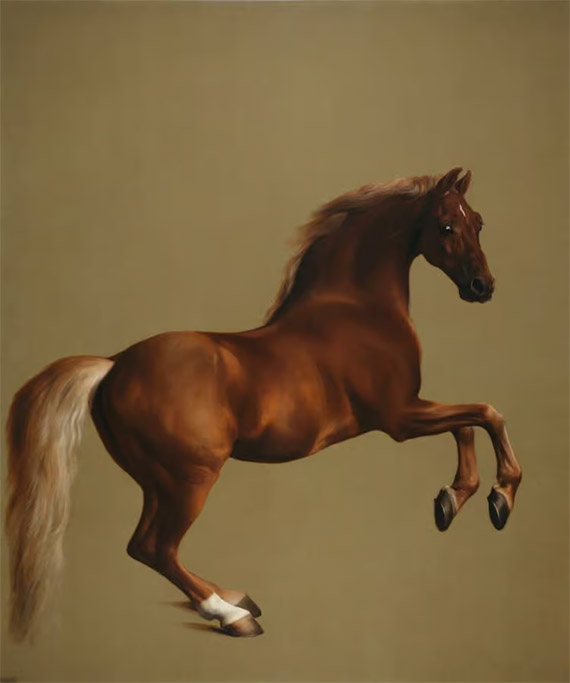
George Stubbs, a British artist known for his horse paintings and animal portraits, was an internationally renowned British artist. In 1762, Stubbs was invited to the rural residence of the Marquess Rockingham in Yorkshire to study different species and create various animal portraits.
The Marquess owned Whistlejacket, the legendary racing horse. Stubbs painted Whistlejacket atop a majestic horse, displaying his strength and elegance in this life-size masterpiece.
George Stubbs was not like many famous painters of his time. He learned to paint by studying the works of other artists during his formative years. Historians and critics consider Stubbs’ 1762 piece Whistlejacket one of the most famous horse paintings.
The backdrop was unambiguous and directed the viewer's gaze to this iconic steed.
Napoleon Crossing the Alps by Jacques-Louis David

During the 18th and 19th centuries, Napoleon Bonaparte was a dominant figure in Europe. His armies had claimed vast territories across the continent, achieving what many deemed unattainable. One such accomplishment was Napoleon's trek through the Swiss Alps to bolster his forces in Northern Italy. This triumphant maneuver against his adversaries inspired the artwork in discussion.
This creation stands as a testament to the artist's brilliance and ranks among his most celebrated pieces. It's also a prominent depiction of equine art. Here, Napoleon is portrayed atop a steed, guiding his men towards the peaks of the Swiss Alps. In the backdrop, one can observe his troops and artillery navigating the rugged terrain, a path untraversed by vast armies during the colder months.
Theodore Gericault, The 1821 Derby in Epsom (1821)

Theodore Gericault, an eminent French artist from the early 1800s, deeply appreciated horses' graceful dynamics. He briefly served in the royal stables at Versailles, acquainting himself with various equine breeds and their functionalities. This artwork is among his most recognized. It captures a riveting horse race, with four jockeys in close proximity.
Gericault was an avid horse rider. Rumor has it that injuries from his daring rides at breakneck speeds played a role in his deteriorating health. This painting is hailed as one of the most iconic equine artworks.
The piece was commissioned by a renowned English equine enthusiast, showcasing one of his prized horses clinching victory in a countryside race.
Horse Frightened By a Thunderstorm by Eugene Delacroix
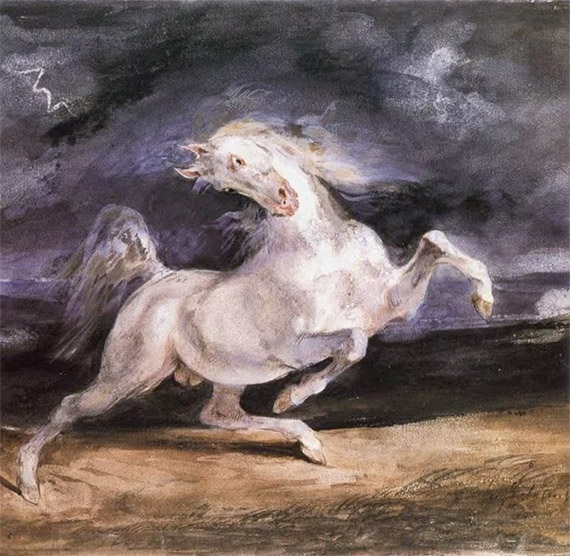
Eugene Delacroix, a pivotal contributor to the French Realism movement in the early 1800s, crafted numerous equine-centric artworks, often set against coastal backdrops. In the 1820s, he produced a work solely centered on a horse, likely drawing inspiration from Gericault's creations.
In this piece, Delacroix paints a tempestuous sky illuminated intermittently by streaks of lightning.
Delacroix depicts a sky darkened by the lightning bolts flickering in the clouds. The fierce storm is shown as a horse that has been startled and rises to respond to thunder and lightning. Delacroix is believed to have created this watercolor during that time.
The Horse Fair by Rosa Bonheur
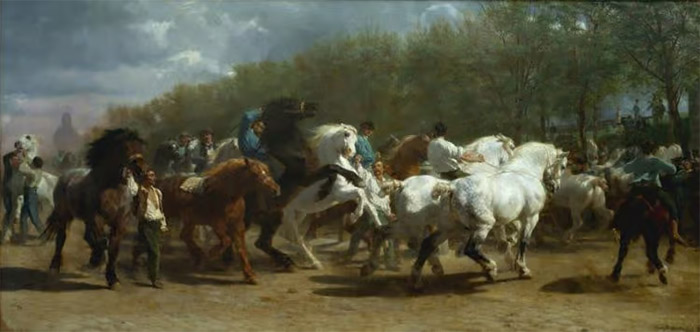
Artist Rosa Bonheur (1822-1899) Date 1855 Medium oil on canvas Current Location Metropolitan Museum of Art in New York, USA
The artist spent an entire year on location. He created sketches that he would later finish. He found a lot of inspiration in a wide range of masterpieces. The painting received much praise when it was first shown at the Salon in 1853. The painting is also a great example of one of the most influential genres in the 19th century.
It influenced many horse painting artists, both historical and modern, around the world. Rosa Bonheur is more than a talented artist.
She was also an independent and strong woman. When she started this painting, Bonheur was already a well-known artist, especially of animals. It was not surprising that she chose to depict the Parisian Horse Market.
The way she has monumentalized everyday life through her subject is spectacular and vital. The picture is a perfect example of 19th-century Realism.
The Parade of Race Horses before the Tribunes by Edgar Degas

Edgar Degas has been hailed by many as one of the greatest Impressionist painters. His most famous works often depict unusual situations or individuals, which many critics felt were unworthy for such a gifted painter to consider. Edgar Degas created several other masterpieces during his lifetime.
This image shows a grouping of thoroughbred horses getting ready for a race at a famous horse racing venue. Art critics know that this work is a good example of Degas' ability to create a painting that accurately portrays the sun’s lighting effect on a scene in a manner typical for the painter.
This famous artwork is often replicated and displayed in horse racing societies in the United States and Europe, where the sport has a huge following.
Lady Godiva by John Collier

John Collier, an English artist well-known in the late 19th and early 20th centuries, is a name you should know. John Collier is renowned for his paintings that depict historical events and mythology in England. Collier's version of Lady Godiva is one of his most notable works. The image is based on a portrait of a bride from the 13th-century Earl of Mercia.
Folklore says that she rode naked through Coventry to protest a tax her husband Leofric levied. Mab Paul's face, a famous model and stage actor from that era, appears in the artwork, along with a very realistic depiction of the event.
She is riding a white horse with a regal dress, halter, and saddle.
Max Liebermann, Two Riders on a Beach
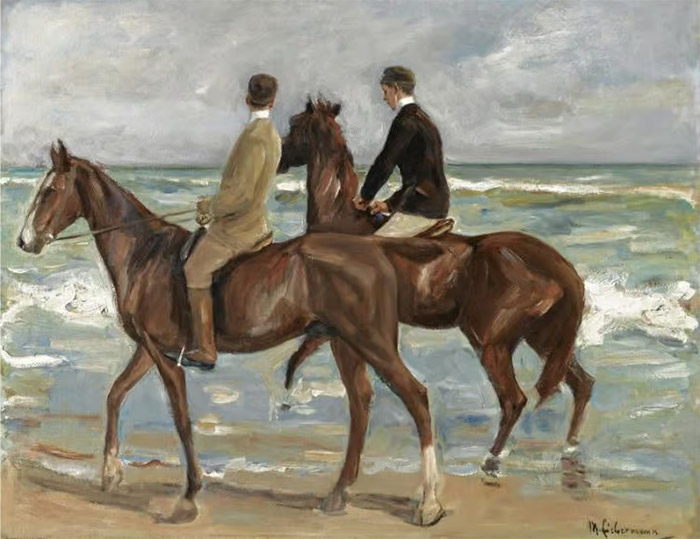
The work's aesthetic quality and tragic backstory are both remarkable. This was one of hundreds of works of art taken by Nazis during World War II. It was created by German Impressionist Max Liebermann. He also collected a large collection of French Impressionist works.
Cornelius Gurlitt was arrested in Germany as the son of Hildebrand Gurlitt in 2012. The Liebermanns chose to sell the picture after receiving it back. Sotheby's valued the picture at approximately $865,000.
In 2015, however, a bidder paid $2.9m for the painting. This was three times what the estimate had been. Liebermann was an ardent supporter of the separation of politics and arts. The same picture is available in two different versions. David Friedmann, a wealthy Jewish sugar producer in Breslau at the time, bought one of these copies.
Blue Horses by Franz Marc
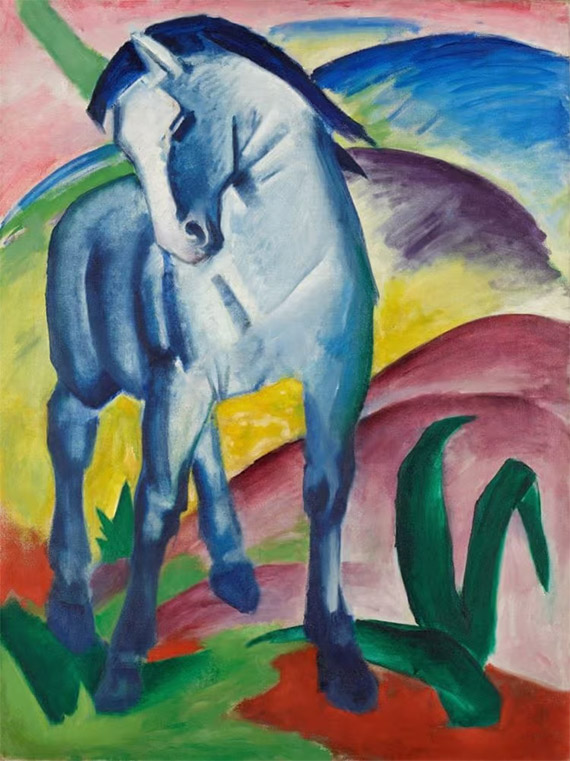
Franz Marc loved painting animals and horses in particular. He was a highly spiritual person who believed animals to be pure and close to God. In addition, he had color beliefs. He believed that blue was masculine and yellow feminine. In this painting, the horses appear muscular and strong yet soft and emotional. Marc's connection with the natural world can be seen in this painting.
Franz Marc uses vibrant colors and curving lines. The hills in the background echo the horse's curves. Note how the horses fill the painting almost entirely and have become abstract. Abstraction is the process of changing, reorganizing, or twisting anything to its original state.
Franz Marc painted this painting before his life ended at Verdun when he was 36.
La Femme au Cheval (1911) by Jean Metzinger
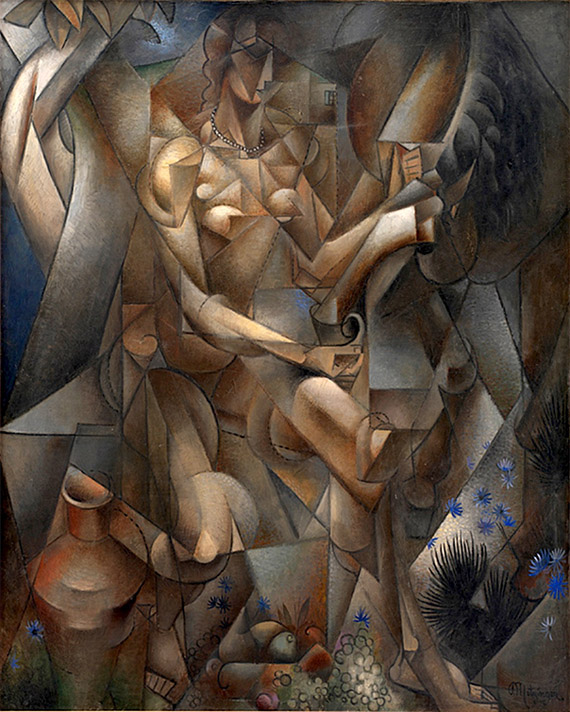
Cubist painters often used familiar themes and situations but portrayed them from different angles to highlight their main subjects. Metzinger, a Cubist painter, was widely respected in the early 20th Century when Cubism had just begun to gain traction throughout Europe.
Metzinger is known for this work, including a human and an animal figure. The artwork was first shown at the Salon des Independants, Paris, in the year Metzinger completed it. The ability of this painting to portray several elements from the painting's main subjects simultaneously was praised both by critics and the audience.
This concludes our examination of 10 famous horse pictures that have captured the world's imagination over the years. Painting horses is a genre that has remained popular, even in the age of technology and fast cars. There is something about horses that captures people's attention. Horse painting artists have captured the characteristics of equines humans love.
FAQs
Why do horse painting artists portray horses?
Horses and animals in the surrounding area were among the first things humans painted. Since ancient times, horses have played a vital role in human development. They helped us to explore new territories, trade goods and people, and help us discover new ones. Although they may not be as famous for transportation in the West, enthusiasts and hobbyists still love and ride them.
Who is the most famous horse painting artist?
Many famous horse painters have appeared over the years. Many artists have painted racing horses. Edgar Degas, arguably, is the most famous.
No Comments Yet...